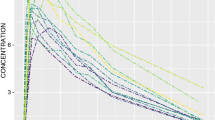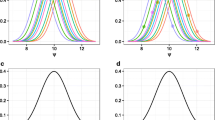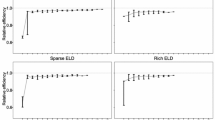Abstract
We consider the situation where we wish to adjust the dosage regimen of a patient based on (in general) sparse concentration measurements taken on-line. A Bayesian decision theory approach is taken which requires, the specification of an appropriate prior distribution and loss function. A simple method for obtaining samples from the posterior distribution of the pharmacokinetic parameters of the patient is described. In general, these samples are used to obtain a Monte Carlo estimate of the expected loss which is then minimized with respect to the dosage regimen. Some special cases which yield analytic solutions are described. When the prior distribution is based on a population analysis then a method of accounting for the uncertainty in the population parameters is described. Two simulation studies showing how the methods work in practice are presented.
Similar content being viewed by others
References
L. B. Sheiner, B. Rosenberg, and K. L. Melmon. Modeling of individual pharmacokinetics for computer-aided drug dosage.Comput. Biomed. Res. 5:441–459 (1972).
S. Vozeh and J. J. Steimer. Feedback control methods for drug dosage optimization: concepts, classifications and clinical application.Clin. Pharmacokin. 10:468–480 (1985).
J. Gaillot, J. J. Steimer, A. Mallet, J. J. Thebault, and A. Beider. A priori lithium dosage regimen using population characteristics of pharmacokinetic parameters.J. Pharmacokin. Biopharm. 7:579–628 (1979).
A. W. Kelman, B. Whiting, and S. M. Bryson. OPT: a package of computer programs for parameter optimization in clinical pharmacokinetics.Br. J. Clin. Pharmacol. 14:247–256 (1982).
L. B. Sheiner and S. L. Beal. Bayesian individualization of pharmacokinetics: simple implementation and comparison with non-Bayesian methods.J. Pharm. Sci. 71:1344–1348 (1982).
O. Richter and D. Reinhardt. Methods for evaluating optimal dosage regimens and their application to theophylline.Int. J. Clin. Pharm. 20:564–575 (1982).
D. Katz and D. Z. D'Argenio. Implementation and evaluation of control strategies for individualizing dosage regimens, with application to the aminoglycoside antibiotics.J. Pharmacokin. Biopharm. 14:523–537 (1986).
D. Z. D'Argenio and D. Katz. Application of stochastic control methods to the problem of individualizing intravenous theophylline therapy.Biomed. Meas. Inform. Contr. 3:115–122 (1988).
C. Hu, W. S. Lovejoy, and S. L. Shafer. An efficient control strategy for dosage regimens.J. Pharmacokin. Biopharm. 22:73–94 (1994).
J. C. Wakefield. An expected loss approach to the design of dosage regimens via sampling-based methods.Statistician 43:13–29 (1994).
A. F. M. Smith and A. E. Gelfand. Bayesian statistics without tears: a sampling resampling perspective.Am. Statist. 46:84–88 (1992).
B. D. Ripley.Stochastic Simulation, Wiley, New York, 1987.
A. Mallet. A maximum likelihood estimation method for random coefficient regression models.Biometrika 73:645–656 (1986).
M. Davidian and A. R. Gallant. Smooth nonparametric maximum likelihood estimation for population pharmacokinetics, with application to quinidine.J. Pharmacokin. Biopharm. 20:529–556 (1992).
J. C. Wakefield, A. F. M. Smith, A. Racine-Poon, and A. E. Gelfand. Bayesian analysis of linear and nonlinear population models using the Gibbs sampler.Appl. Statist. 43:201–221 (1994).
J. E. Bennett and J. C. Wakefield. Comparison of population software using the monoexponential model.J. Pharmacokin. Biopharm. (submitted).
N. G. Best, K. K. C. Tan, W. R. Gilks, and D. J. Spiegelhalter. Estimation of population pharmacokinetics using the Gibbs sampler.J. Pharmacokin. Biopharm. (in press).
J. C. Wakefield. The Bayesian analysis of population pharmacokinetic models.J. Am. Statist. Assoc. 91:306–319 (1996).
Author information
Authors and Affiliations
Rights and permissions
About this article
Cite this article
Wakefield, J. Bayesian individualization via sampling-based methods. Journal of Pharmacokinetics and Biopharmaceutics 24, 103–131 (1996). https://doi.org/10.1007/BF02353512
Received:
Accepted:
Published:
Issue Date:
DOI: https://doi.org/10.1007/BF02353512




